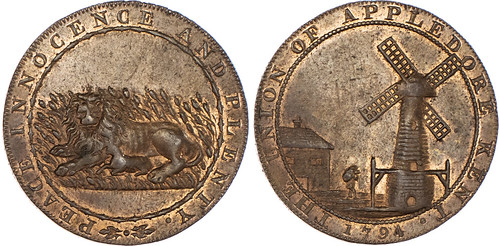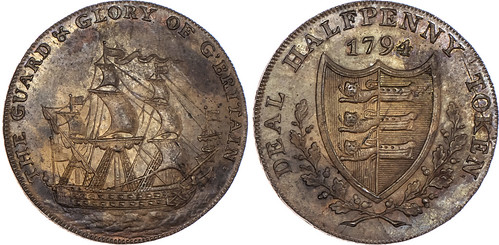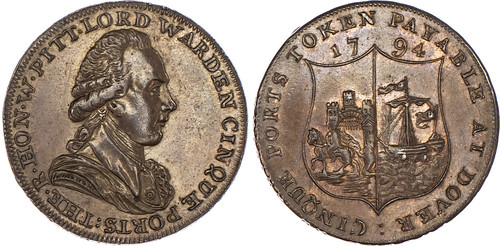
PREV ARTICLE
NEXT ARTICLE
FULL ISSUE
PREV FULL ISSUE
THE 1790S BRITISH COPPER COIN SHORTAGEOn May 25th Baldwin's will be selling Patrick Deane's collection of Eighteenth Century Tokens. This article from their blog describes some Kent pieces. -Editor William Peckham was a general shopkeeper in Appledore in southern Kent and issued his own ‘Halfpenny' in order that he could give change in the shop. He produced a marvellous coin with one side showing a lamb sleeping with a lion and a legend proclaiming PEACE, INNOCENSE AND PLENTY which is probably a sentiment based on Britain's continuing war with France and the deprivations and hardships it caused. On the other side a windmill is portrayed which would have been a common feature on the landscape at that time. The coin is copper and about 30mm wide. In the 1790s there was no official small copper change in the country. Britain was at war with France and the price of copper had risen causing the regal issue to ‘vanish'. This caused tremendous hardship for small merchants and shop keepers throughout the country, for how were they to conduct the everyday transactions of selling small goods if they had no change. The Crown was busy with the war and any ‘unofficial' production of coin of the realm would be seen as forgery which was punishable by hanging ! Eventually a Welsh mining company hit upon the idea of turning their copper straight into pennies and halfpennies but calling them ‘tokens' that were redeemable in official coin – thus avoiding the forgery problem. As they were the correct weight, no one bothered to change them and in the space of a year, merchants in every town in England started issuing their token pence ! On the edge of the Peckham's halfpenny, pictured here, is the legend PAYABLE AT W. PECKHAM'S APPLEDORE, thus stating that it was redeemable as a halfpenny token and not an actual halfpenny ! This solved the lack of small change in the 1790s and for ten years, until the government got its act together after the war and issued official copper coins. Throughout this last decade of the eighteenth century, it is these copper ‘token' pence and halfpence one would have had in one's pocket, all over the country, as small change. There were many merchants in Kent issuing their own coppers, particularly in the town of Canterbury, and also other smaller localities such as Sandwich, Romney marsh, Dover, Hythe, Dymchurch, Brookland, Tenterden. Staplehurst, Lamberhurst, Maidstone, Deptford, Benenden, Deal, Faversham Goudhurst, Hawkhurst Sheerness, Bromley and Chatham. The halfpenny token used at Deal in 1794 was issued by Richard Long who was a bookseller and ran a library there. Newspapers would be sent down from London and these ‘reading rooms' were the main source of information – especially regarding the war with France! Long was fairly prominent in the town and was on the Town Council and also an agent for Kent Life and Annuity Office. His token features a man-of-war with the legend THE GUARD AND GLORY OF G' BRITAIN which had particular relevance in these troubled times. The reverse bears the cinque Port arms of nearby Sandwich. Another bookseller and library owner issued a token in Dover, John Horn, as well as having the ‘Public reading Room' in King Street, also operated the Apollo Circulating Library which circulated that part of Kent. His establishment in King Street was not just a mere reading room but more a fashionable lounge with music and a watering hole for the gentry. On his token he featured the Prime Minister William Pitt who was also Lord Warden of the Cinque Ports and on the reverse, the Cinque port arms of Dover. The tokens for all these Kent localities can be seen in an auction of 18th. century Tokens being held by A H Baldwin & Sons on the 25th. of May. This is one of the finest collections of these tradesmen's tokens to come onto the market in many years and each piece can be viewed on https://thestrand.com/departments/coins#upcoming-auctions They provide a marvellous window into this last decade of the eighteenth century. Every English county is represented and nearly every English city and market town has a merchant or shopkeeper issuing their own coins and for ten years it was a truly a coinage ‘of the people, by the people, for the people'.
To read the complete article, see:
Wayne Homren, Editor The Numismatic Bibliomania Society is a non-profit organization promoting numismatic literature. See our web site at coinbooks.org. To submit items for publication in The E-Sylum, write to the Editor at this address: whomren@gmail.com To subscribe go to: https://my.binhost.com/lists/listinfo/esylum All Rights Reserved. NBS Home Page Contact the NBS webmaster 
|



